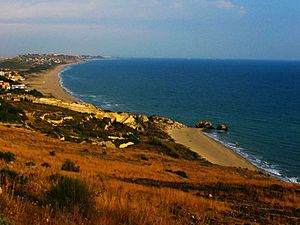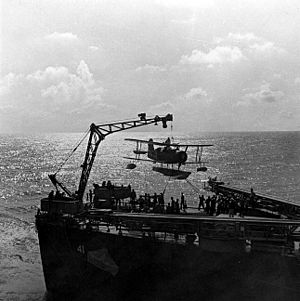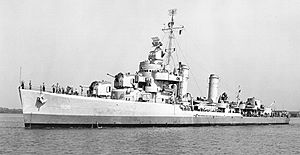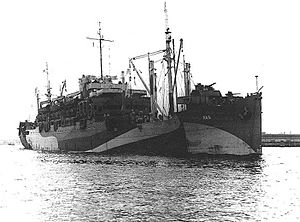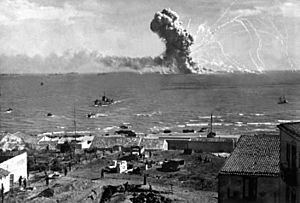Battle of Gela (1943) facts for kids
Quick facts for kids Battle of Gela (1943) |
|||||||
|---|---|---|---|---|---|---|---|
| Part of the Allied invasion of Sicily in the Mediterranean theatre of World War II | |||||||
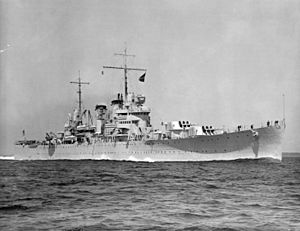 Brooklyn-class cruisers Boise (pictured) and her sister ship Savannah, demonstrated the effectiveness of naval gunfire against tanks. |
|||||||
|
|||||||
| Belligerents | |||||||
| Commanders and leaders | |||||||
| Strength | |||||||
| 1st Infantry Division (United States) 2nd Armored Division (United States) USS Savannah USS Boise HMS Abercrombie USS Shubrick USS Jeffers USS Maddox USS Butler USS Glennon |
Italian XVIII Coastal Brigade 4th Infantry Division "Livorno" Fallschirm-Panzer Division 1 Hermann Göring Luftflotte 2 |
||||||
| Casualties and losses | |||||||
| U.S.: 2,300 casualties 1 destroyer sunk |
Italian: 3,350 killed 5,000 wounded 2,000 prisoners German: 630 killed, wounded, and prisoners 14 tanks |
||||||
The Battle of Gela was a major fight during World War II. It happened when American forces landed on the coast of Sicily, an island in Italy. This battle was the very first part of the American plan to invade Sicily.
During the battle, ships from the United States Navy helped land United States Army soldiers. These soldiers faced tough attacks from German and Italian tanks and planes. The battle showed how important naval ships were for supporting troops on land. It also highlighted challenges in getting air support during such landings.
Contents
Why the Battle of Gela Happened
The Allied invasion of Sicily was a big step in World War II. It happened after the Allies (like the US and Britain) had won in North Africa. The goal was to take pressure off the Soviet Union on the Eastern Front. It also prepared the way for future invasions into Europe.
General Dwight D. Eisenhower led the ground forces. Admiral Andrew Cunningham was in charge of the naval forces. Air support was limited because Allied fighter planes had to fly very far. This meant they couldn't stay over the battle for long.
Where the Battle Took Place
Gela is a fishing town on a plateau about 150 feet (46 meters) high. It has a beach with a long pier. The land behind the town was mostly farms. The Gela River is about 1 mile (1.6 km) east of the pier. The Acate River is about 5 miles (8 km) east of the Gela River.
A key area was the Piano Lupo highland, about 7 miles (11 km) northeast of Gela. This spot was important because several roads met there. These roads connected Gela to other towns like Niscemi and Caltagirone.
Who Fought for the Allies
The American forces included the Seventh United States Army. Lieutenant General George S. Patton led these soldiers. Vice Admiral Henry Kent Hewitt commanded the huge fleet of 601 ships. This fleet carried thousands of soldiers and their equipment.
The invasion was the first time many new types of landing ships were used. These included tank landing ships (LSTs). The American forces were divided into three main groups. Task Force H was assigned to land near Gela. It included the 1st Infantry Division and Rangers.
Who Fought for the Axis
The Italian XVIII Coastal Brigade defended the Gela beaches. The town itself was protected by the Italian 429th Coastal Battalion. They used barbed wire, concrete pillboxes, and anti-tank guns. The beaches also had mines and machine guns.
The Italian 4th Infantry Division "Livorno" was positioned nearby. They had older R35 tanks. Later, about 9,000 German soldiers from the Fallschirm-Panzer Division 1 Hermann Göring arrived. They brought 46 Panzerkampfwagen III and 32 Panzerkampfwagen IV tanks. Another German group, the 15th Panzergrenadier Division, brought 17 powerful Tiger I tanks.
Axis air forces, including the German Luftflotte 2 and Italian Regia Aeronautica, also provided air support. They had many planes ready at bases in Sicily and Italy.
Getting Ready for Battle
The Allied ships sailed from North Africa on July 5. On July 9, German forces in Sicily spotted the convoys. Strong winds created huge waves, making many soldiers seasick. The winds calmed down that evening as the ships got closer to Sicily.
As the ships anchored, American paratroopers were dropped from planes. However, strong winds scattered them widely. Fewer than 200 of 3,400 paratroopers reached the important Piano Lupo highland. This was before the Italian Livorno Division arrived there.
The American ships anchored about 6 miles (9.7 km) off the Gela River. The Navy wanted to bombard the area before the invasion. But the Army hoped for a surprise attack and said no.
The Battle Begins
July 10: The First Landings and Counterattacks
Unloading of troops began shortly after midnight. The first American soldiers landed around 2:45 AM. The Rangers landed near the Gela pier. Other regiments landed east of the Gela River.
Axis planes started bombing at 4:21 AM. The American destroyer Maddox was hit by an Italian bomb and sank quickly. Other ships were damaged. Allied fighter planes were supposed to protect the area, but they were often not there when Axis planes attacked. This made ships feel they had to defend themselves.
The Rangers attacked Gela town to capture the pier. Italian defenders blew up the pier at 2:40 AM. But the Rangers captured the town by 8:00 AM. They took 200 prisoners and some Italian artillery. The 1st Infantry Division aimed to capture the Ponte Olivo Airfield within 24 hours.
After sunrise, minesweepers cleared mines for the LSTs to land vehicles. But Italian artillery fired heavily on the beaches. This damaged landing craft and supplies. Minefields on land also stopped American vehicles. By noon, almost no American artillery or tanks had been landed. Unloading was slow and often stopped by air attacks.
American cruisers like Boise and Savannah launched small observation planes. These planes helped spot targets for the ships' guns. But German planes quickly shot down these slow planes.
The Italian Livorno Division launched a three-part counterattack. They attacked Gela from the west and east with infantry and tanks. American destroyers like Shubrick fired their guns, destroying some tanks. The Rangers used captured Italian guns to fight back.
The German Hermann Göring Division also attacked later in the day. They pushed through American lines but stopped when they faced naval gunfire. As night fell, the Germans pulled back to regroup. American reserve forces, including tanks, began landing. However, an LST carrying anti-tank artillery was bombed and caught fire. This stopped more LSTs from unloading.
Axis air raids continued through the night. The Luftwaffe flew 370 missions and lost 16 planes. The Italian Air Force flew 141 missions and lost 11 planes.
July 11: Holding the Line
The first American tanks landed at 2:00 AM but got stuck in the soft beach sand. Axis air raids started again at 6:35 AM. One bomb hit the transport ship Barnett, killing seven soldiers. This was the start of 14 air raids that day.
The Axis launched a big, coordinated attack. The Italian Livorno Division attacked Gela from the west. The German Hermann Göring Division attacked the beachhead from the east with 60 tanks. The German tanks got very close to the beach.
American tanks that had just landed went straight into action. Every soldier on the beach, even those not usually in combat, helped form a firing line. Ships provided heavy gunfire support. Boise fired on the German tanks, destroying many of them.
The Italian infantry attacking Gela was stopped by Savannah's gunfire. The Rangers took 400 prisoners. The Axis tanks began to pull back as night fell.
Later that afternoon, a Liberty ship called Robert Rowan was hit by bombs. Its cargo of ammunition exploded, lighting up the area for more bombing raids. Many ships were damaged.
July 12: Victory at Gela
By dawn, 90 percent of the invasion convoy had been unloaded. The 1st Infantry Division captured the Ponte Olivo airfield at 8:45 AM. This was about 27 hours later than planned.
Allied fighter planes finally began to break up Axis bomber raids. The number of Axis bombing missions was cut in half. Ships continued to provide fire support. General Patton moved his headquarters ashore.
American ground support planes landed at Ponte Olivo airfield as soon as it was safe. They provided air support for the ongoing fight against German and Italian forces. The Battle of Gela ended with an American victory.
Images for kids


